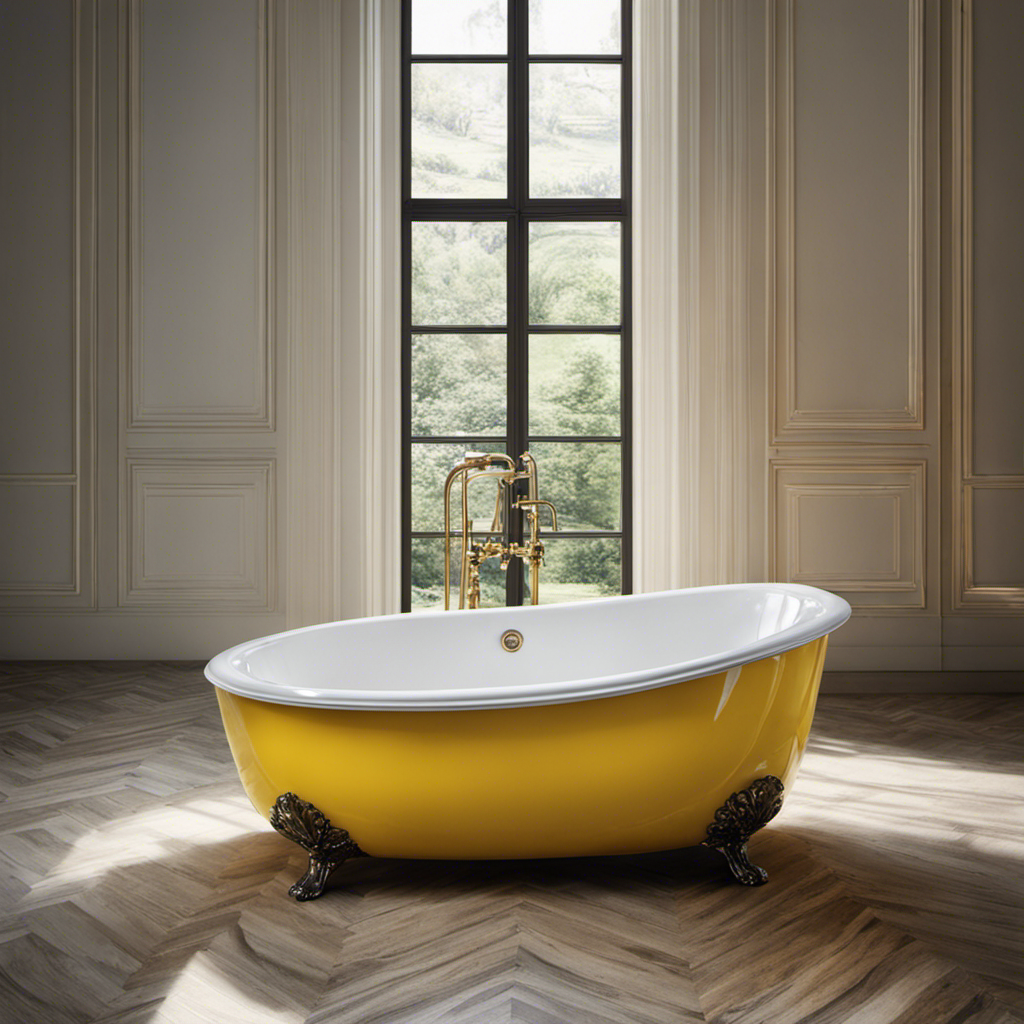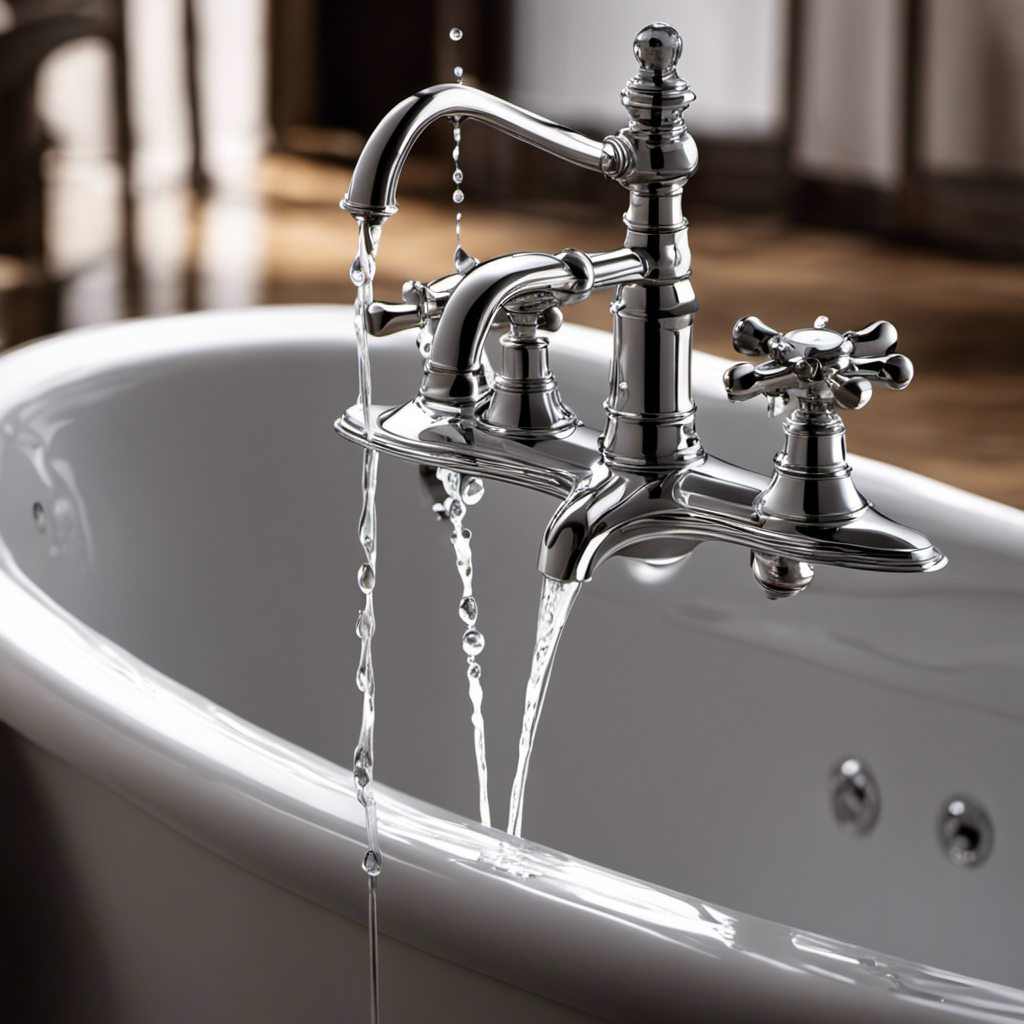I know firsthand the frustration of dealing with yellow stains in my bathtub. It’s not only unsightly, but it can also be a challenge to remove.
But what causes these stubborn stains in the first place? In this article, I will explore the various culprits behind those yellow marks. From hard water deposits to soap scum buildup, we’ll uncover the reasons behind this common bathroom annoyance.
So, let’s dive in and discover what’s really causing those pesky yellow stains in your bathtub.
Key Takeaways
- Yellow stains in bathtubs are often caused by mineral deposits from hard water.
- Rust stains occur when iron particles come into contact with water and oxygen, causing them to break down and create rust.
- Soap scum buildup can contribute to yellow stains in bathtubs.
- Mold and mildew growth can also cause yellow stains in bathtubs if proper bathroom hygiene and maintenance are not followed.
Hard Water Deposits
If you have hard water, you’ll likely notice yellow stains in your bathtub caused by mineral deposits. Hard water contains high levels of minerals like calcium and magnesium. When the water evaporates, these minerals are left behind, forming hard water stains. These yellow stains can be quite stubborn and difficult to remove.
To tackle hard water stains, you’ll need to use cleaning products specifically designed to dissolve mineral deposits. Look for cleaners with ingredients like citric acid or vinegar, as they are effective in breaking down the minerals and removing the stains.
Once you’ve successfully removed the hard water stains, it’s important to take preventive measures to avoid future buildup. Regularly cleaning and maintaining your bathtub will help prevent the accumulation of mineral deposits.
Now, let’s move on to the next issue: rust and iron stains.
Rust and Iron Stains
To remove rust and iron stains from your bathtub, you can try using a mixture of vinegar and baking soda. Rust stains occur when iron oxidation takes place on the surface of your bathtub. Iron oxidation happens when iron particles come into contact with water and oxygen, causing them to break down and create rust.
These rust stains can be unsightly and difficult to remove. By using a mixture of vinegar and baking soda, you can effectively break down the rust and remove the stains. Vinegar acts as a mild acid that helps dissolve the rust, while baking soda provides an abrasive texture to scrub away the stains.
To prevent future rust stains, it is important to keep your bathtub dry and avoid leaving any iron-containing objects in contact with the surface.
Soap Scum Buildup
Soap scum buildup can be effectively removed from your bathtub using a mixture of vinegar and baking soda. This combination creates a powerful cleaning solution that helps break down and dissolve the soap residue. Here are some key points to consider when dealing with soap scum removal:
- Use a spray bottle to apply the vinegar and baking soda mixture directly onto the affected areas.
- Allow the solution to sit for about 15-20 minutes to allow it to penetrate the soap scum.
- Scrub the surface with a non-abrasive sponge or brush to help loosen and remove the buildup.
- Rinse the bathtub thoroughly with warm water to remove any remaining residue.
Preventing soap scum from forming in the first place is also important. Here are some tips:
- Use liquid soap instead of bar soap, as it tends to leave less residue.
- Wipe down the bathtub after each use to remove any soap residue.
- Regularly clean your bathtub using a mild cleaner to prevent soap scum buildup.
Mold and Mildew Growth
When it comes to bathroom hygiene and maintenance, it’s important to be knowledgeable about common cleaning methods and how to prevent future mold growth.
As a professional, I understand the importance of maintaining a clean and healthy bathroom environment.
In this discussion, I’ll provide insights on effective cleaning techniques and tips for ensuring a mold-free bathroom.
Bathroom Hygiene and Maintenance
Regular cleaning and proper maintenance can help prevent the buildup of yellow stains in the bathtub. It is crucial to maintain good bathroom hygiene to ensure a clean and stain-free bathtub. Here are some important points to consider:
- Use effective bathroom cleaning products specifically designed for removing stains and grime from bathtubs.
- Regularly scrub the bathtub surface using a soft brush or sponge to remove any dirt or residue that might contribute to staining.
- Rinse the bathtub thoroughly after each use to remove any soap scum or leftover cleaning products.
Common Cleaning Methods
To effectively remove stubborn stains, it’s important to explore common cleaning methods.
There are a variety of common cleaning products available that can help tackle tough stains in your bathtub. One option is a bleach-based cleaner, which can be effective in removing yellow stains caused by mold or mildew.
Another common cleaning method is using an abrasive cleaner, such as a powdered cleanser or baking soda. These products can help scrub away stains and restore the shine to your bathtub.
However, if you prefer natural cleaning alternatives, there are options available as well. For example, a mixture of vinegar and water can be used to remove stains and disinfect the bathtub. Additionally, lemon juice or hydrogen peroxide can also be effective in tackling stubborn stains.
Preventing Future Mold Growth
Using a bleach-based cleaner regularly can help prevent mold from growing in the future. Mold thrives in damp environments, so keeping the bathtub dry after each use is essential.
Here are some cleaning techniques that can aid in preventing discoloration and mold growth:
- Use a scrub brush or sponge to remove soap scum and dirt from the bathtub surface.
- Apply a bleach-based cleaner to kill any existing mold spores and prevent their regrowth.
- Rinse the bathtub thoroughly after cleaning to remove any residue.
By following these cleaning techniques, you can maintain a clean and mold-free bathtub, preventing discoloration and ensuring a hygienic bathing environment.
Now, let’s explore another issue that can affect the appearance and cleanliness of your bathtub: mineral buildup.
Mineral Buildup
As an expert in bathroom maintenance, I have come across various issues related to mineral buildup in bathtubs.
Hard water deposits, caused by high levels of minerals like calcium and magnesium, can leave unsightly stains and residue on the surface of the tub.
Additionally, the presence of rust and iron oxidation can further contribute to the accumulation of stubborn stains.
Lastly, soap scum, formed by the reaction between soap and hard water, can create a sticky film that is difficult to remove.
Understanding these key points is crucial in effectively addressing and preventing mineral buildup in bathtubs.
Hard Water Deposits
Hard water deposits can cause yellow stains in the bathtub. These mineral deposits, commonly known as hard water stains, occur when water containing high levels of minerals such as calcium and magnesium evaporates, leaving behind a residue. Understanding the causes and remedies for hard water stains is essential for maintaining a clean and visually appealing bathtub.
Here are three key points to consider:
- Hard water stains are formed when water with high mineral content comes into contact with surfaces and leaves behind a residue.
- Regular cleaning and maintenance can prevent the buildup of hard water deposits and minimize the appearance of yellow stains.
- Using specialized cleaning products, such as those containing citric acid or vinegar, can effectively dissolve and remove hard water deposits from the bathtub surface.
Rust and Iron Oxidation
To prevent rust and iron oxidation, you should regularly clean and maintain your bathtub. Iron corrosion is a common issue that can lead to water discoloration and unsightly stains in your tub. When iron in the water reacts with oxygen, it forms rust, which can accumulate on the surface of your bathtub. This rust can cause the water to appear yellow or brown and can stain the bathtub over time.
Regular cleaning and maintenance can help prevent the buildup of iron and rust. Using a mild detergent and a soft cloth, gently clean the surface of the bathtub to remove any dirt or grime. Additionally, it is important to address any plumbing issues that may be causing iron to enter your water supply.
Soap Scum Accumulation
When cleaning your bathtub, make sure to address the issue of soap scum accumulation. Soap scum is a common problem that occurs when soap and hard water minerals combine, leaving a sticky, unsightly residue on the surface of your tub.
To prevent soap scum buildup, consider using a liquid soap instead of bar soap, as it tends to produce less residue. Additionally, regularly wiping down the tub with a squeegee or towel after each use can help minimize soap scum formation.
If soap scum has already accumulated, there are several effective methods for removing it. Some options include using a mixture of vinegar and water, a commercial soap scum remover, or a baking soda paste.
Remember to always follow the manufacturer’s instructions and test any cleaning solution on a small, inconspicuous area first to avoid damaging the tub.
Chemical Reactions
You can easily prevent yellow stains in your bathtub by understanding the chemical reactions that cause them.
Bathtub discoloration is often the result of a complex series of chemical reactions that occur between the water, cleaning products, and the surface of the tub.
When water containing dissolved minerals comes into contact with soap residue or other organic matter, it can lead to the formation of yellow stains. This is due to the reaction between the minerals and the organic compounds, resulting in the deposition of insoluble substances on the bathtub surface.
Understanding these chemical reactions can help you choose the right cleaning products and techniques to prevent or remove yellow stains effectively.
Regular cleaning and maintenance can prevent the buildup of soap scum and minimize the occurrence of bathtub discoloration.
Conclusion
In conclusion, the yellow stains in your bathtub can be caused by a variety of factors. Hard water deposits, rust and iron stains, soap scum buildup, mold and mildew growth, and mineral buildup are all possible culprits.
Understanding the causes of these stains can help you effectively tackle the problem. By using appropriate cleaning techniques and products, you can eliminate these unsightly stains and restore the pristine condition of your bathtub.
Remember to regularly maintain your bathtub to prevent future buildup and enjoy a clean bathing experience.










